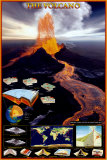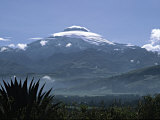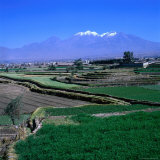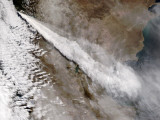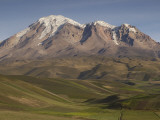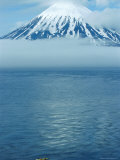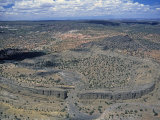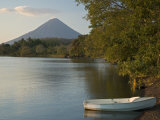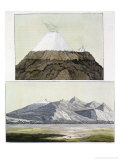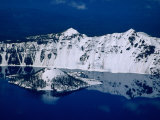|
|
|
|
|
Cayambe, the third highest mountain in Ecuador, is a stratovolcano with a permanent snowcap.
FYI ~ On the south slope of Cayambe is the highest point of the Equator in the world.
|
|
|
|
Nevado Chachani, one of highest volcanoes in southern Peru, has archaeological remains near the summit.
|
|
|
|
The volcanic caldera Chaiten is located in southern Chile near the Gulf of Corcovado.
Chaiten, which had been inactive for 9,500 years, began erupting in May of 2008; almost all inhabitants of the town of Chaitén and nearby villages were evacuated. The seimic and volcanic activity caused lahars, or flows of mud and debris, that in turn caused flooding that destroyed Chaiten. The town is being rebuilt.
Chaiten eruptions produced a translucent grey obsidian (volcanic glass) which was used by pre-Columbian cultures for artifacts.
|
|
|
|
Mount Chimborazo is an inactive startovolcano in Ecuador.
Chimborazo's distinction is its summit being the furthest from the center of the Earth, all due to the equatorial bulge.
|
|
|
|
Mount Cleveland is a symmetrical stratovolcano on the remote Chuginadak Island at the western end of the Aleutian Arc.
The Native American Aleut name, Chuginadak, is after their fire goddess and refers to the almost constant activity of the volcano.
The name Cleveland was given in 1894 to honor President Grover Cleveland.
|
|
|
|
The Mexican stratovolcano Colima, currently one of the most active volcanos in North America, has erupted more than 40 times since 1576.
Colima, located 300 miles west of Mexico City, is designated a Decade Volcano.
|
|
|
|
Coliseum Maar is part of the Hopi Buttes Volcanic Field in north central Arizona.
A maar is a volcanic cones that forms from phreatic explosions near the surface.
|
|
|
|
Concepcion, and the smaller Maderas volcanoes, form the island of Ometepe in Lake Nicaragua.
Concepcion is an active stratovolcano that has erupted at least 25 times since 1883.
|
|
|
|
Cotopaxi, a stratovolcano in the Andes Mountains, is located just 28 km (17 mi) south of Quito, the capital of Equador.
Part of the chain of volcanoes known as the Pacific Ring of Fire, Cotopaxi is one of the highest active volcano in the world, at 19,347 ft., and has one of the few equatorial glaciers.
The greatest danger of a huge eruption of Cotopaxi would be the flow of ice from its glacier. Eruptions in the 1700s destroyed the colonial town of Latacuga, today the suburban areas of Quito are in the line of danger.
|
|
|
|
Crater Lake Caldera is a lake located in the caldera of the collapsed volcano named Mount Mazama. Crater Lake is located in the Cascade Mountains of Oregon, and is a US national park.
No rivers flowing into or out of the lake; evaporation is compensated for by rain and snowfall at a rate that the total amount of water is replaced every 250 years.
FYI - The Klamath tribe of Native Americans, who may have witnessed the collapse of Mount Mazama and the formation of Crater Lake, have long regarded the lake as a sacred site.
|
|
|
previous page | top | next
volcanoes > a | b | C | d | e | f-g | h-i-j | k | l | m | n-o | p | q-r | s | t | u-v | w-z < mountains
|
|
I have searched the web for visual, text, and manipulative curriculum support materials - teaching posters, art prints, maps, charts, calendars, books and educational toys featuring famous people, places and events - to help teachers optimize their valuable time and budget.
Browsing the subject areas at NetPosterWorks.com is a learning experience where educators can plan context rich environments while comparing prices, special discounts, framing options and shipping from educational resources.
Thank you for starting your search for inspirational, motivational, and educational posters and learning materials at NetPosterWorks.com. If you need help please contact us.
|
|
|




